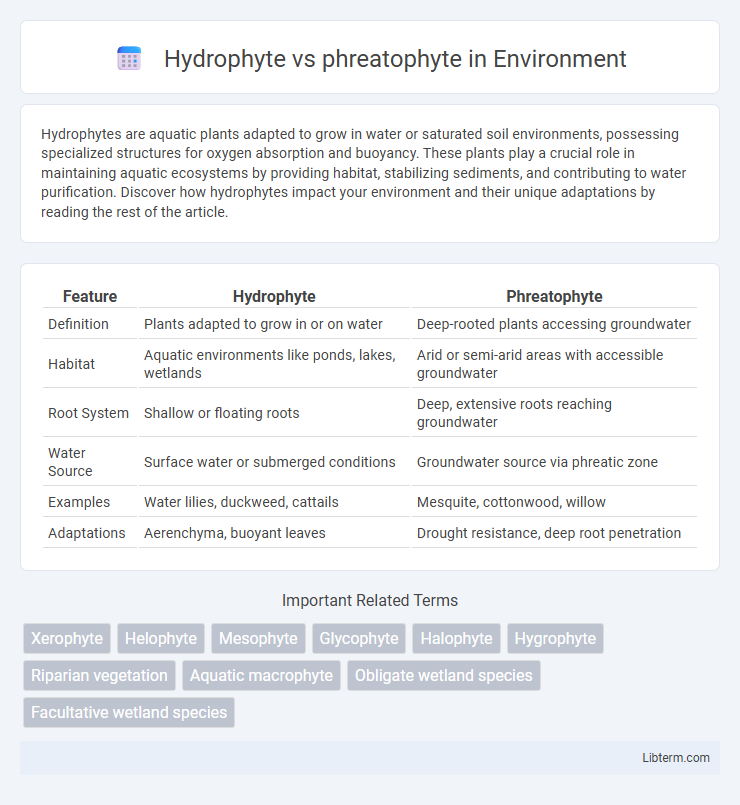Hydrophytes are aquatic plants adapted to grow in water or saturated soil environments, possessing specialized structures for oxygen absorption and buoyancy. These plants play a crucial role in maintaining aquatic ecosystems by providing habitat, stabilizing sediments, and contributing to water purification. Discover how hydrophytes impact your environment and their unique adaptations by reading the rest of the article.
Table of Comparison
| Feature | Hydrophyte | Phreatophyte |
|---|---|---|
| Definition | Plants adapted to grow in or on water | Deep-rooted plants accessing groundwater |
| Habitat | Aquatic environments like ponds, lakes, wetlands | Arid or semi-arid areas with accessible groundwater |
| Root System | Shallow or floating roots | Deep, extensive roots reaching groundwater |
| Water Source | Surface water or submerged conditions | Groundwater source via phreatic zone |
| Examples | Water lilies, duckweed, cattails | Mesquite, cottonwood, willow |
| Adaptations | Aerenchyma, buoyant leaves | Drought resistance, deep root penetration |
Introduction to Hydrophytes and Phreatophytes
Hydrophytes are aquatic plants adapted to grow in water or very moist environments, possessing specialized structures like aerenchyma for oxygen transport. Phreatophytes, on the other hand, are deep-rooted plants that access groundwater through extensive root systems, often found in arid or semi-arid regions. Both plant types play crucial roles in their ecosystems by influencing water dynamics and soil properties.
Defining Hydrophytes: Aquatic Plant Adaptations
Hydrophytes are aquatic plants specially adapted to grow in water-rich environments, featuring traits such as aerenchyma for buoyancy and reduced cuticles to facilitate gas exchange. Their adaptations include submerged or floating leaves and extensive root systems optimized for oxygen-poor substrates. In contrast, phreatophytes possess deep roots that access groundwater, thriving in arid or semi-arid regions rather than fully aquatic habitats.
What Are Phreatophytes? Characteristics and Ecology
Phreatophytes are deep-rooted plants that access groundwater through extended root systems reaching the water table, enabling survival in arid and semi-arid environments. They exhibit characteristics such as tolerance to prolonged drought, extensive root networks, and the ability to thrive in riparian zones or areas with fluctuating water availability. Ecologically, phreatophytes play crucial roles in stabilizing soil, maintaining groundwater levels, and supporting biodiversity in desert ecosystems by linking surface and groundwater resources.
Key Differences Between Hydrophytes and Phreatophytes
Hydrophytes are aquatic plants adapted to grow in water-saturated environments, equipped with specialized structures like aerenchyma for buoyancy and gas exchange, while phreatophytes are deep-rooted plants that access groundwater through extensive root systems, thriving in arid or semi-arid regions. Hydrophytes typically have soft, flexible stems and leaves with reduced cuticles, enabling efficient underwater photosynthesis, whereas phreatophytes possess tough, drought-resistant tissues to minimize water loss. The primary ecological difference lies in their water source: hydrophytes depend on surface or submerged water, and phreatophytes rely on groundwater accessed via phreatic zones.
Habitat Comparison: Aquatic vs. Groundwater Environments
Hydrophytes thrive in aquatic habitats such as ponds, lakes, and marshes where their entire or partial structure is submerged in water, adapting to oxygen-poor environments with specialized tissues like aerenchyma. Phreatophytes inhabit groundwater environments, accessing deep water tables through extensively developed root systems that penetrate soil layers, enabling survival in arid or semi-arid regions with fluctuating water availability. The distinct habitat preferences highlight hydrophytes' adaptation to surface or near-surface water bodies, while phreatophytes rely on subterranean water sources for sustenance.
Morphological Adaptations: Roots, Stems, and Leaves
Hydrophytes exhibit morphological adaptations such as aerenchyma tissue in roots and stems to facilitate oxygen transport in waterlogged environments, along with broad, flexible leaves to maximize surface area for photosynthesis. Phreatophytes develop deep, extensive root systems that penetrate groundwater sources, allowing access to water in arid conditions, with sturdy, narrow leaves adapted to reduce water loss. These structural differences reflect specialized survival strategies, optimizing water acquisition and gas exchange in contrasting habitats.
Water Uptake Strategies: Surface Water vs. Groundwater
Hydrophytes absorb water primarily from surface or saturated soil environments, utilizing specialized tissues like aerenchyma to facilitate oxygen transport and efficient water uptake. Phreatophytes access groundwater directly through deep, extensive root systems that penetrate below the water table, allowing survival in arid or semi-arid conditions. The contrasting water uptake strategies highlight hydrophytes' adaptation to inundated habitats versus phreatophytes' reliance on stable groundwater sources.
Ecological Roles and Environmental Importance
Hydrophytes, adapted to grow in aquatic environments, play a crucial role in maintaining water quality by filtering pollutants and providing habitat for aquatic organisms. Phreatophytes, characterized by their deep root systems reaching groundwater, contribute to stabilizing soil moisture levels and preventing erosion in arid and semi-arid ecosystems. Both plant types enhance biodiversity and support ecosystem resilience by facilitating nutrient cycling and sustaining wildlife dependent on water resources.
Common Examples: Representative Species
Hydrophytes include species like water lilies (Nymphaea spp.), cattails (Typha spp.), and duckweeds (Lemna spp.), thriving in aquatic or water-saturated environments. Phreatophytes commonly consist of deep-rooted plants such as mesquite (Prosopis spp.), cottonwood (Populus deltoides), and willows (Salix spp.), which access groundwater through extensive root systems. These representative species illustrate the distinct adaptations of hydrophytes and phreatophytes to their respective water sources.
Applications in Restoration and Landscape Management
Hydrophytes, adapted to aquatic or saturated soils, are crucial in wetland restoration for stabilizing shorelines, improving water quality through nutrient uptake, and providing habitat for aquatic fauna. Phreatophytes, with deep root systems accessing groundwater, are essential in arid landscape management to control erosion, lower water tables to prevent soil salinization, and support vegetation in dry environments. Integrating hydrophytes and phreatophytes strategically enhances ecosystem resilience and functionality in restoration projects targeting diverse hydrological conditions.
Hydrophyte Infographic

 libterm.com
libterm.com